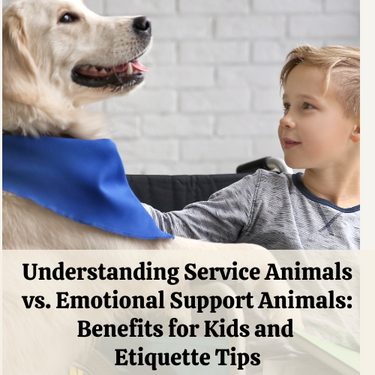
Today, we see them service animals and emotional support animals everywhere as they assist people with a wider range of conditions, and in all settings. Many children grow up fascinated by animals, and for some, animals can play a vital role in their emotional or physical well-being. For kids with special needs, animals such as service animals and emotional support animals (ESAs) can provide significant benefits.
While both types of animals offer support, there are key differences between them, including their roles, legal recognition, and how they are approved. This article will explore these differences, explain how they can benefit children, and provide guidance on how to talk to kids about service and emotional support animals, whether they have one themselves or know someone who does.
What Is a Service Animal?
A service animal is a dog that has been specifically trained to perform tasks for a person with a disability. These tasks can include guiding someone who is visually impaired, alerting a person who is deaf, pulling a wheelchair, alerting and protecting a person who is having a seizure, or reminding a person with mental illness to take prescribed medications. In the United States, the Americans with Disabilities Act (ADA) defines service animals and grants them the right to accompany their handlers in public places, including restaurants, schools, and other facilities.
Key Points:
What Is an Emotional Support Animal?
An emotional support animal (ESA) provides comfort to individuals with emotional or psychological conditions. Unlike service animals, ESAs do not require specialized training to perform tasks. They simply offer companionship, which can help alleviate feelings of anxiety, depression, and loneliness. ESAs can be any type of animal, including dogs, cats, birds, or even rabbits.
Key Points:
Differences Between Service Animals and Emotional Support Animals
Understanding the differences between service animals and emotional support animals can help children and their families navigate their needs and rights:
1. Training and Tasks: Service animals are trained to perform specific tasks related to a disability, while ESAs provide general emotional comfort.
2..Legal Status: Service animals are protected under the ADA, which allows them access to public spaces. ESAs do not have the same level of legal protection and are generally only allowed in specific housing situations or on flights.
3. Types of Animals: Only dogs (and in some cases, miniature horses) can be considered service animals, while ESAs can be any animal that provides comfort.
Benefits of Service Animals and Emotional Support Animals for Kids
Both service animals and emotional support animals can greatly benefit children, especially those facing challenges.
1. Increased Independence:
2. Emotional Support:
3. Physical Health:
4. Teaching Responsibility:
Who Approves Service Animals and Emotional Support Animals?
Service Animals:
Emotional Support Animals:
Considerations for Families
When considering a service animal or emotional support animal, families should keep in mind:
Talking to Kids About Service and Emotional Support Animals
You’ll find dogs helping people with vision, mobility and hearing impairment, as well as conditions that may not be apparent, such as autism, seizures, post-traumatic stress disorder, food allergies, and diabetes. Yet most adults still aren’t certain of the protocol for interacting with a service animal, or its handler. Service animals are not pets. They are specially trained for their duties, and it can cost $20,000 or more to equip one for its role. Vests indicate that they are legally allowed to accompany their handler into businesses. The vest also is a sign to the public that the handler has a disability and that the dog is on duty.
Emotional support animals may not always be as easy to identify as the service animals, and children, who often get excited and curious when they see a dog, need to be taught how to respond to one – and its owner or handler - while it is on the job. It’s important to understand and teach our children the etiquette of encountering Service Animals and Emotional Support Animals. There are several things to teach your children about service animals and their handlers. Many of the rules are simply common sense and common courtesy. Here’s a few key points to promote understanding and etiquette:
Resources
There are many age-appropriate resources to help your children understand service dog etiquette.
Both service animals and emotional support animals play important roles in supporting children, particularly those facing unique challenges. Understanding the differences between these types of animals can empower families to make informed decisions and create supportive environments for their children.
If you or someone you know is considering a service or emotional support animal and would like more guidance, reach out to the therapists at KIDStherapyfinder for support and resources

Sign up for our newsletter to get instant access to parenting resources sent directly in your inbox!
